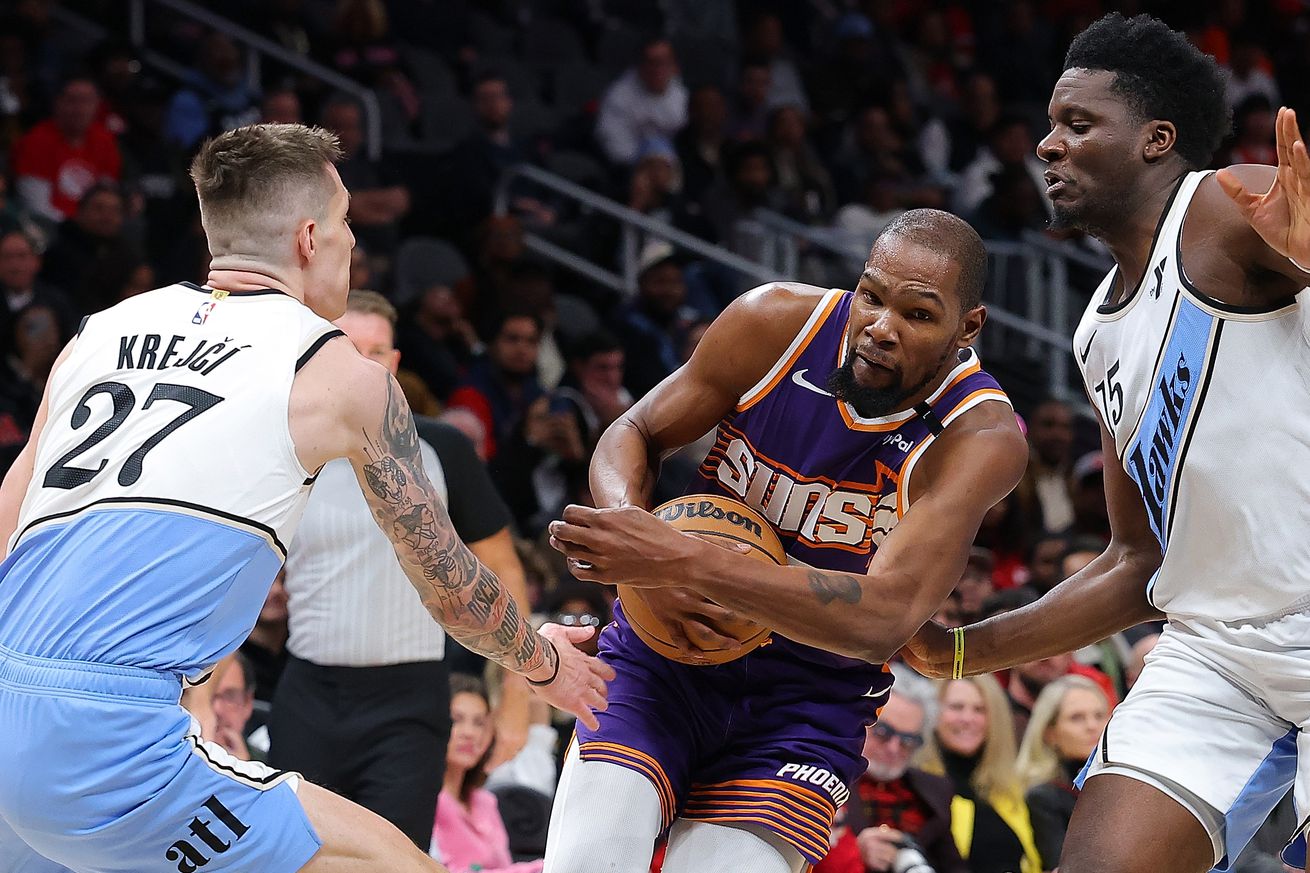
Time to talk about the *slaps living room floor* defense.
After picking up a scrappy, shorthanded victory in Chicago on Wednesday night, the Atlanta Hawks will officially enter the second half of the season north of the .500 mark irrespective of the outcome of tomorrow night’s tilt against the Boston Celtics with the team’s record sitting at 21-19 through their first 40-games of the 2024-25 season.
While there is still a lot of basketball left to be played, and I’d stop (extremely) short of hanging any banners for this fairly blasé accomplishment, it is worth noting the extent to which this squad has surpassed their preseason expectations* thus far — with ESPN’s Kevin Pelton projecting the Hawks to finish with around 32 wins (11th in the Eastern Conference) in his annual preseason win projections article, and DraftKings Sportsbook placing Atlanta’s over/under for wins at a modest 36.5 (9th in the East) prior to opening night.
*No shots intended, but the consensus amongst your pals here at Peachtree Hoops was that this team would in fact crack the .500 mark this season (our predictions were released after the preseason) — though as referenced above, we certainly won’t be taking any victory laps until the season is over.
According to the “Strength of Schedule” metrics from the good folks over at dunksandthrees, the Hawks have played the ninth easiest schedule*, the 13th most difficult defensive schedule and the third easiest offensive schedule in the league as of January 16th (and subsequently rank 20th in net rating, 18th in offensive rating and 20th in defensive rating), so things will certainly get tougher from here. However for now, this team deserves some flowers for an extremely bright start to the season.
*From the site (link here): this metric gives us the “in-season strength of opponent players faced to date given EPM and actual minutes played. Higher means tougher opponent players.” The website uses the same method to break down this metric into offensive strength of schedule and defensive strength of schedule. Very cool stuff.
Now the real work begins.
As I touched on last week, the fast-paced, unselfish, and disruptive style of play that the Hawks’ have adopted in 2024-25* has led to some impressive results this season, and even though they’ve had to manage injuries to a couple of key players over the past month, it’s been encouraging to see the team continue to stick to their principles, and not deviate from their play style despite the fluidity in the rotation.
*Atlanta ranks second in pace, third in assist percentage and second in steals per game this season.
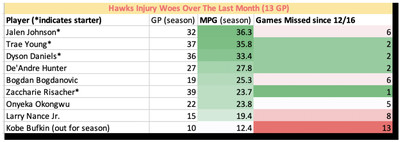
I wrote about Atlanta’s offense and the uptick in three-point shooting (from Trae Young in particular) last time I checked in, so today I’d like to focus on the defense — which has taken a step in the wrong direction over the past month — and point out a few worrying numbers related to their play on this end of the floor.
A quick note before getting into the meat and potatoes.
Despite how much I enjoyed the heroics of Atlanta’s two-way players in Wednesday night’s victory over Chicago, I thought it best not to include that game in the sample size analyzed for this piece because A) the Hawks were missing four out of five starters as well as sixth man De’Andre Hunter for the contest, resulting in the Quin Snyder using a very unusual rotation that we will likely never see again this season and B) the Bulls looked like a team that forgot that they had a basketball game scheduled on Wednesday night, lacking energy and attentiveness all night long, culminating in an eye-watering* 91.3 non-garbage time offensive rating (including a whopping 19.4% turnover percentage) per cleaningtheglass.
Needless to say, if you caught the game (and even if you didn’t), I’m sure you’ll understand.
*and sample size skewing!
Now, onto the analysis.
Analyzing Atlanta’s defense over the past month
It’s no secret that the Atlanta Hawks’ defense has been the team’s most glaring flaw for as long as Trae Young has been the face of the franchise — and yet through the first two months (27 games) of the season* it looked like change was afoot, as the Hawks were on pace to post their best league-wide ranking in defensive rating (17th) since the 2016-17 season**, allowing a respectable 113.4 points per 100 possessions up until December 15th.
*Through the Atlanta Hawks’ NBA Cup Semifinals defeat to the Milwaukee Bucks
**They finished 18th in defensive rating in 2020-21
Since then, however, their defense has unfortunately taken a step back, with the team allowing 116.2 points per 100 possessions over the past month (not including their game against Chicago on Jan. 15) which ranks just 26th in the league over this span.
While it’s reasonable (and probably a little fair) to point to the team’s recent injury struggles as the reason for this slippage, looking at the lineup data, it’s a little disheartening to see that the starting unit of Young/Daniels/Risacher/Johnson/Capela* has posted a porous 117.2 defensive rating across four games played (42 minutes) since December 15th after allowing just 110.7 points per 100 possessions through the first two months of the season (239 minutes across 22 games played for this group through December 15th).
*Even despite the injuries, this five-man unit is the Hawks’ most used five-man lineup over both stretches (the first two months of the season, as well as the last one month)
This number becomes even more eyebrow raising when you consider the fact that none of the four teams (San Antonio, Minnesota, Chicago, LA Lakers) that this unit played against over the past month currently rank in the top-10 in offensive rating.
Looking at where things have gone askew for the starters, while their defensive shot profile hasn’t changed all that much*, and they are still getting pummeled from beyond the three-point arc**, the biggest dropoff has actually been seen in their rim protection as these lineups’ opponents have shot 19-for-25 (76%) at the rim over the past month after shooting just 58% from this area of the floor through the first two months of the season.
*Per pbpstats, these lineups’ opponent rim-or-three frequency was 74.95% through the first two months of the season, and is 74.68% over the past month
**Per pbpstats, these lineups were allowing their opponents to shoot 42.6% on corner threes and 38.5% on above-the-break threes through the first two months of the season. Over the past month, they’ve allowed opponents to shoot 42.9% from the corner and a whopping 44.4% on above-the break threes. More on the opponent three-point shooting below.
Of course, we’re dealing with minuscule sample sizes here (due to injuries, all five starters have been on the court for less than 10% of Atlanta’s total minutes played since December 15th), but I went back and watched the possessions where Atlanta gave up a basket at the rim and found that over half of these makes (12, to be exact) stemmed from one of two reasons: turnovers leading to transition possessions for the offense, and Jalen Johnson getting beat backdoor in the halfcourt.
Per pbpstats, Atlanta’s starters have turned the ball over on over 20% of their possessions since December 15th, up from the first two months of the season when their turnover rate was a respectable 14.3%, resulting in more transition possessions like the ones below, which are difficult for most defenses to stop.
Putting the spotlight on Jalen Johnson, it’s absolutely worth noting that Johnson has been one of the Hawks’ most impactful defenders this season according to cleaningtheglass with Atlanta posting an impressive 111.6 defensive rating, allowing 8.2 fewer points per 100 possessions, and causing their opponent’s to shoot 5% worse at the rim* with Johnson on the floor.
*Opponent’s are shooting just 62.7% at the rim with Johnson on the court this season per CTG —- a mark which ranks in the 83rd percentile relative to other 5-man lineups (min. 100 minutes played) this season.
Additionally, all of the possessions below occurred during the game against the Lakers on January 3rd — the only game Johnson has appeared in since the start of the new year (7 possible appearances) due to a bout with “right shoulder inflammation” — so there is certainly a chance that his injury was hampering him during this game.
All that being said, the fact of the matter is that Johnson was beaten not one, not two, but three times (!) in the same game by the same player (Rui Hachimura) against the Lakers. While it doesn’t happen all that often, Johnson is susceptible to a bit of ball watching on the defensive end of the floor. And while his other-worldly athleticism allows him to recover in a lot of these situations, this is something which LeBron James and the Lakers’ scouts evidently picked up on and used to their advantage when playing Atlanta.
On one of the first possessions of the game, LeBron rejects the Anthony Davis screen, takes a few dribbles downhill, looks off Johnson to the corner, then finds a cutting Hachimura for the score.
At the start of the second half, LeBron uses the Davis screen, engages Johnson, then hits Rui with a sweet look-away bounce pass for an open baseline jam.
A few possessions later, Austin Reaves comes off the James and Davis double-screens, with LeBron occupying Risacher, Johnson is the weakside low man, and it’s his job to cover the ‘AD’ roll. The problem is that with Johnson worried about Davis, Hachimura is free once again for a baseline cut. Capela overplays the pass to Davis, opening a seam in the defense for Reaves to connect with Hachimura.
I’m not picking on Johnson (I say all this with love). As I pointed out earlier, his defensive impact has been magnificent this season and he was likely dealing with an injury during the Lakers’ game*. However, given how irreplaceable his size and athleticism are on this Hawks’ team, and that his defense is a crucial part of the team’s success, it’s imperative for him to stay locked in on this end of the court for Atlanta to maximize their potential this season, and beyond.
*Though it’s unclear how much healthy shoulder would’ve helped on any of the plays above
With Johnson sidelined, Quin Snyder has had a difficult time finding a successful defensive formula with others players alongside Young, Daniels, Risacher and Capela — with that four-man subunit seeing their defensive rating soar from 110.2 through December 15th (375 minutes across 22 games played) to 121.1 (101 minutes across nine games played) since then.
I anticipate that getting a healthy and engaged Jalen Johnson back in the rotation will do their defense a world of good.
I’ve talked a lot about the starting unit so far, but to see some of the changes to the team’s overall defense over the past month, their shot profile from cleaningtheglass (which does not account for garbage time) does a good job of summarizing the pain points as of late.
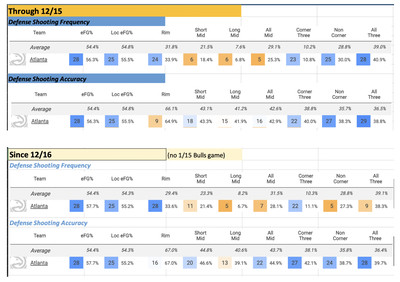
As you can see, while the Hawks are allowing opponent’s to get to the rim at a similar rate as they were through the first two months of the season, their opponents have been more efficient when getting there, shooting 67% (2.1% better) on rim attempts over the past month*.
*While this is also related to the increase in SMR-attempts from Hawks’ opponents, Atlanta has allowed the second-most points in the paint per game since December 15th (54.3), almost eight more paint points than they were allowing through the first two months of the season (46.6).
Jalen Johnson’s impact has been missed in this area — particularly by Clint Capela, who has seen opponent’s raise their rim field goal percentage to 69.6% during his time on the court since December 15th after allowing them to shoot just 61.2% at the rim in his minutes through the first 27 games of the season.
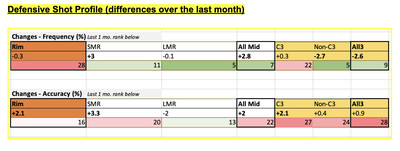
Additionally, while it’s encouraging to see that Atlanta’s opponent’s have traded out a few of their three-point attempts for mid-range attempts over the past one month, it’s quite discouraging to see that the team is still being lit up from beyond the arc. Hawks opponents have shot a ridiculous 39.5% from three over the past month*, the second highest mark in the league over this span per nba.com/stats.
*again, not including the Bulls’ game on 1/15
Interestingly enough, Atlanta has actually done a better job of closing out on their opponent’s three-point attempts over this stretch, allowing the seventh-lowest rate of “wide open”* three-point attempts in the league after allowing the eighth-highest rate of “wide open” three-point attempts through the first two months of the season.
**How nba.com/stats defines three-point attempts without a defender within 6-feet of the shooter
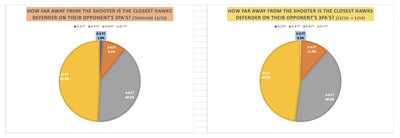
However, as you can see from their defensive shot profile, these efforts have not actually translated to lower opponent three-point percentages as opponent’s are actually shooting better from three-point range than they were through the first two months of the season (37.9%).
Per nba.com/stats, Atlanta ranks in the bottom-10 in the NBA in opponent three-point accuracy on three-point attempts where the closest defender is 2-4 feet away (32.1%), and 4-6 feet away (38.4%) from the shooter this season, and these numbers have hardly budged over the past month, as opponents have shot 32% and 40.9% on these attempts, respectively, despite the improved closeout rate.
While part of the problem here comes down to the Hawks’ doing a poor job of funneling three-point attempts to the proper opposing players, it’s also not out of line to say that some of this simply comes down to bad luck. For example, the same types of attempts (with a defender between 4-6 feet away from the shooter) that Atlanta’s opponent’s have converted at a 41% clip over the past month, Bulls opponents’ are converting at a measly 26.2% clip.
I don’t imagine this difference can be entirely chalked up to a difference in the two team’s closeout techniques and/or strategy.
Conclusion
All in all, it’s clear that this team’s ability to come up with stops on the less glamorous end of the court is going to be one of the biggest factors in the Hawks’ bid to exceed their preseason expectations over the second-half of the season.
Of course, managing their current injuries and getting their rotation back to full strength will help, but they also need to redouble their efforts when it comes to protecting the rim and defending the three-point line.
If they can defend both these areas at a league-average rate, it will not only improve their defensive rating, but give way to more transition opportunities for the offense.
It’s been a very encouraging start to the season for the Atlanta Hawks, but their defense will be an area to watch over this next stretch of games.
All statistics/videos used in this article are from cleaningtheglass.com, pbpstats.com, nba.com/stats, bball-index.com, or dunksandthrees.com
